Lyons W.C. (ed.). Standard handbook of petroleum and natural gas engineering.2001- Volume 1
Подождите немного. Документ загружается.


Drill String: Composition and Design
725
N.C.
70
7%
REG.'
6%
F.H.
5%
1.F.
7
H-90*
N.C. 61
6%
H-90
6% REG.
5%
F.H.
N.C. 56
REG.
I
N.C.50
Reference Line
Figure
4-130a.
Practical chart
for
drill collar selection-2 +-in.
ID.
(From
Drilco, Division
of
Smith International, Inc.)
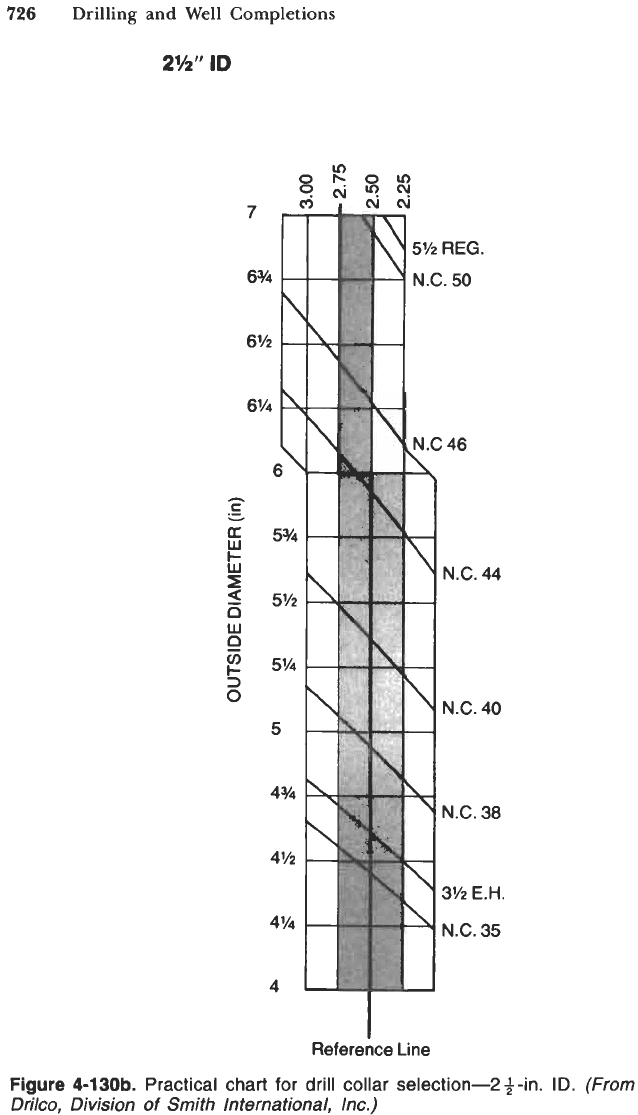
726
Drilling and Well Completions
21h"
ID
Reference Line
Figure
4-130b.
Practical chart for drill collar selection-2 +-in.
ID.
(From
Drilco, Division
of
Smith International, Inc.)
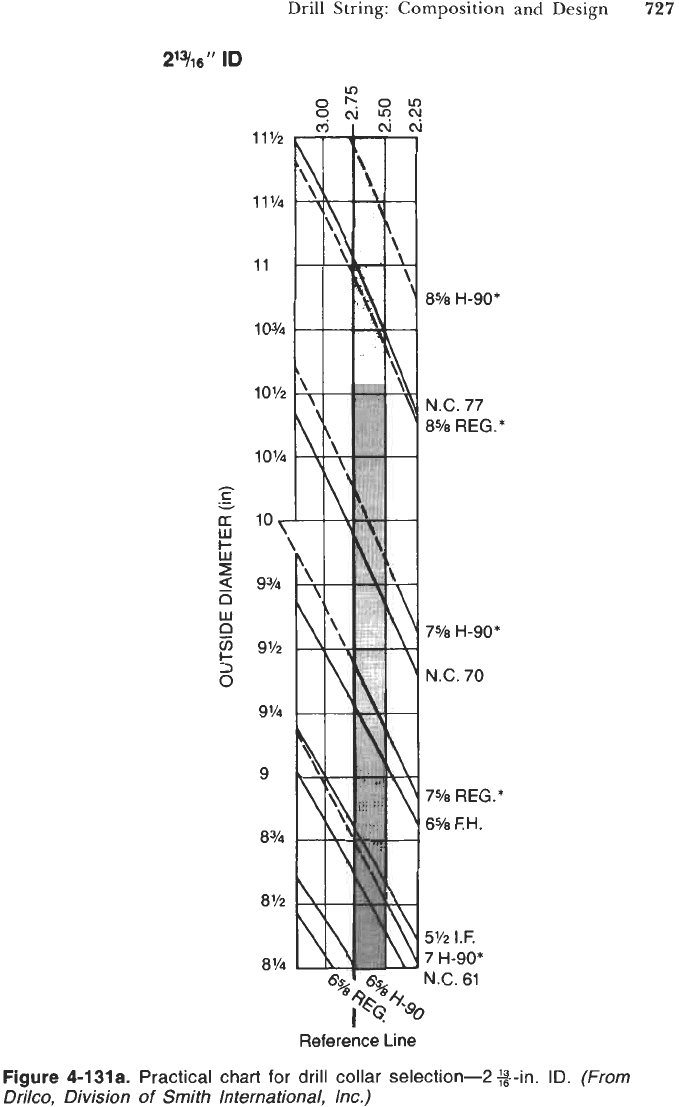
Drill String: Composition and Design
727
Reference Line
Figure
4-131a.
Practical chart for drill collar selection-2 +$-in.
ID.
(From
Drilco, Division
of
Smith International, Inc.)
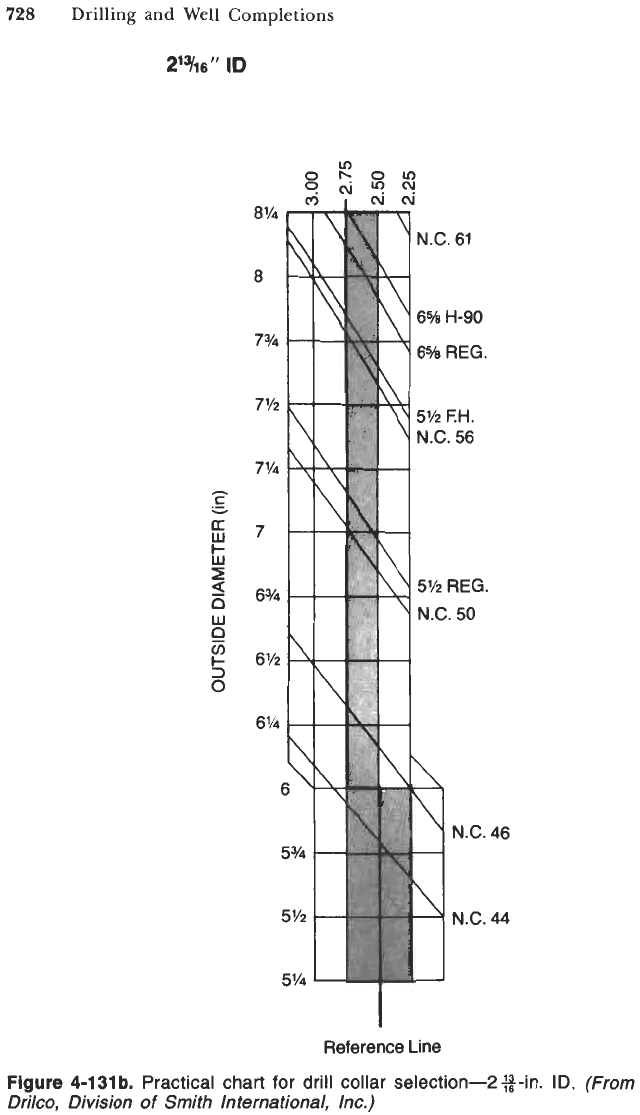
728
Drilling and
Well
Completions
2%
I'
ID
8
7Y4
7%
7'/4
7
6Y4
6Y2
6V4
N.C.
61
6%
H-90
6%
REG.
5Y2
F.H.
N.C.
56
5%
REG.
N.C.
50
N.C.
46
N.C.
44
Y
Reference Line
Figure
4-131
b.
Practical chart for drill collar selection-2 %-in.
ID.
(From
Drilco, Division
of
Smith International, Inc.)
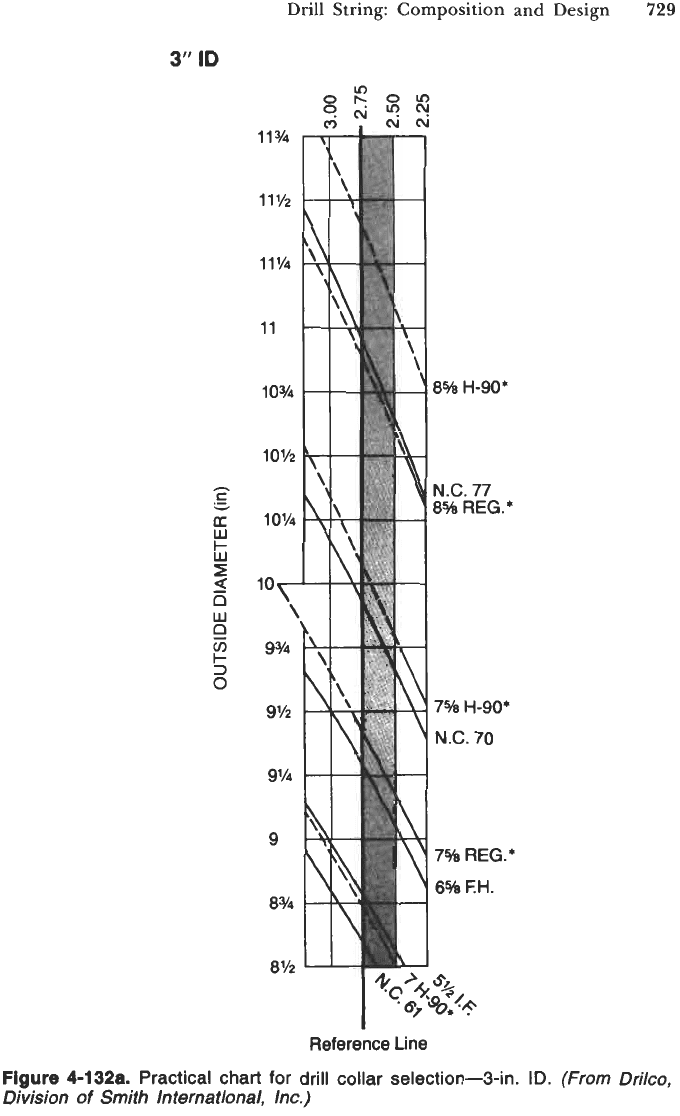
Drill String: Composition
and
Design
729
3”
ID
Reference Line
Figure
4-132a.
Practical chart
for
drill collar selection-3-in.
ID.
(From Drilco,
Division
of
Smith International, Inc.)
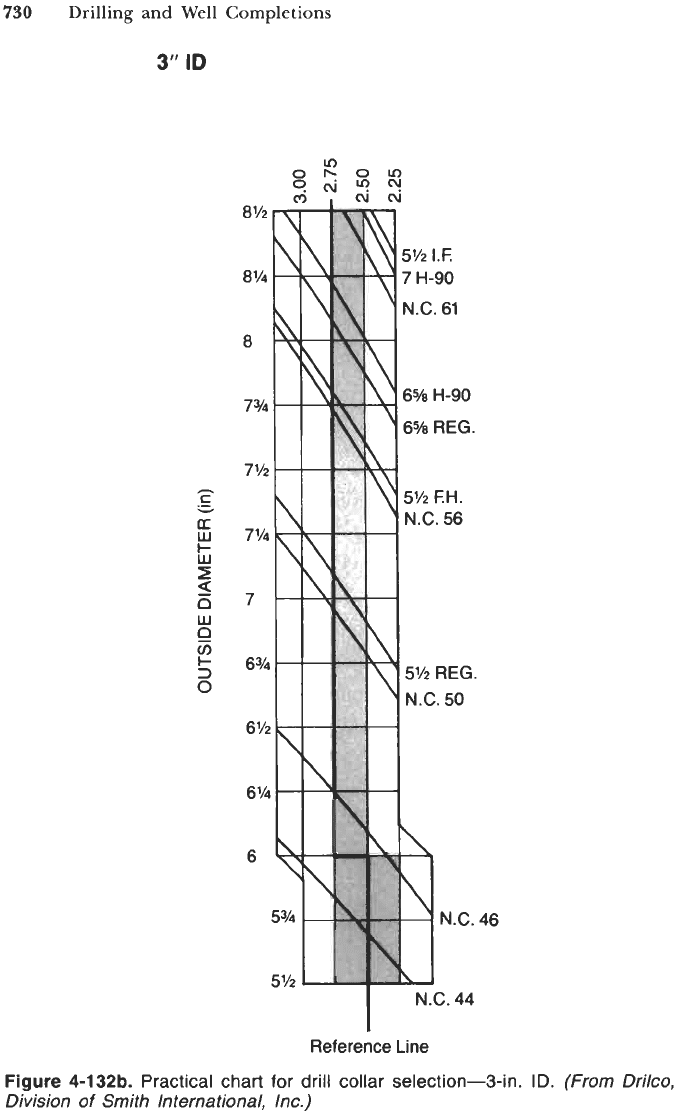
730
Drilling and Well Completions
3”
ID
I
N.C*44
Reference Line
Figure
4-1
32b.
Practical chart
for
drill collar selection-3-in.
ID.
(from Drilco,
Division
of
Smith International, lnc.)
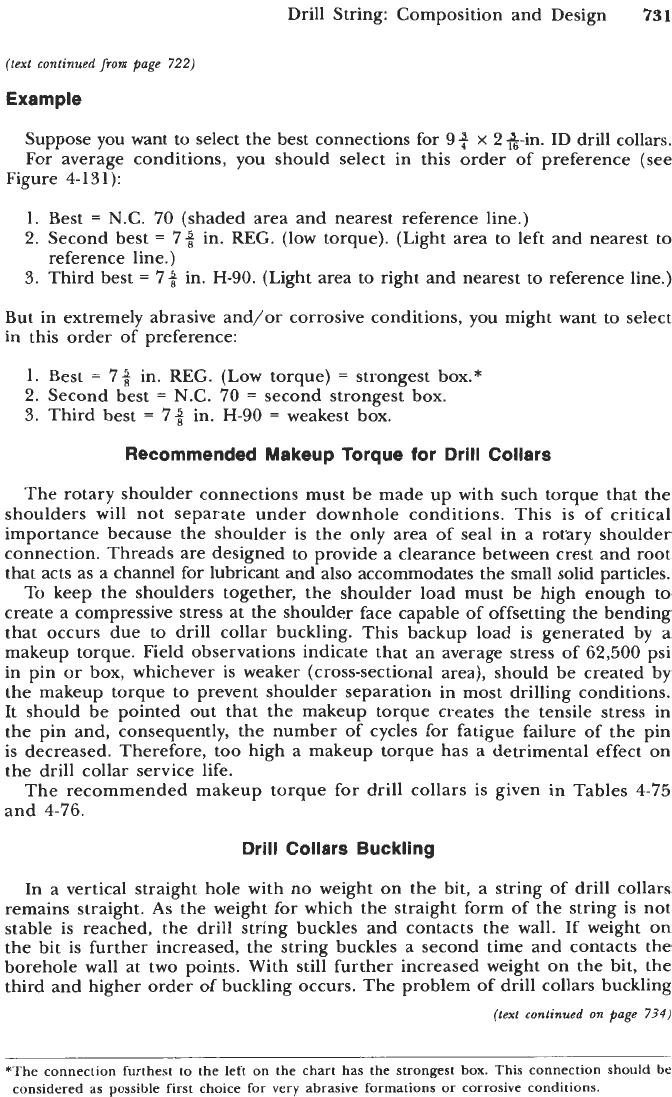
Drill String: Composition and Design
731
(text
continued
from
page
722)
Example
Suppose you want to select the best connections for
9
4
x
2
2-in.
ID
drill collars.
For average conditions, you should select in this order of preference (see
Figure
4-131):
1.
Best
=
N.C.
70
(shaded area and nearest reference line.)
2.
Second best
=
7Q
in. REG. (low torque). (Light area to left and nearest to
3.
Third best
=
79
in.
H-90.
(Light area to right and nearest to reference line.)
But in extremely abrasive and/or corrosive conditions, you might want to select
in this order of preference:
reference line.)
1.
Best
=
79
in. REG. (Low torque)
=
strongest box.*
2.
Second best
=
N.C.
70
=
second strongest box.
3.
Third best
=
79
in.
H-90
=
weakest box.
Recommended Makeup Torque for Drill Collars
The rotary shoulder connections must be made up with such torque that the
shoulders will not separate under downhole conditions. This is of critical
importance because the shoulder is the only area of seal in a rorary shoulder
connection. Threads are designed to provide a clearance between crest and root
that acts as a channel for lubricant and also accommodates the small solid particles.
To keep the shoulders together, the shoulder load must be high enough to
create a compressive stress at the shoulder face capable of offsetting the bending
that occurs due to drill collar buckling. This backup load is generated by a
makeup torque. Field observations indicate that an average stress of
62,500
psi
in pin or box, whichever is weaker (cross-sectional area), should be created by
the makeup torque to prevent shoulder separation in most drilling conditions.
It should be pointed out that the makeup torque creates the tensile stress in
the pin and, consequently, the number of cycles for fatigue failure of the pin
is decreased. Therefore, too high a makeup torque has a detrimental effect on
the drill collar service life.
The recommended makeup torque for drill collars is given in Tables
4-75
and
4-76.
Drill Collars Buckling
In a vertical straight hole with no weight on the bit, a string of drill collars
remains straight.
As
the weight for which the straight form of the string is not
stable is reached, the drill string buckles and contacts the wall.
If
weight
on
the bit is further increased, the string buckles a second time and contacts the
borehole wall at two points. With still further increased weight on the bit, the
third and higher order of buckling occurs. The problem
of
drill collars buckling
(text continued
on
page
7?4)
*The connection furthest
to
the left
on
the chart has the strongest box. This connection should he
considered as possible first choice
for
very abrasive formations
or
corrosive conditions.
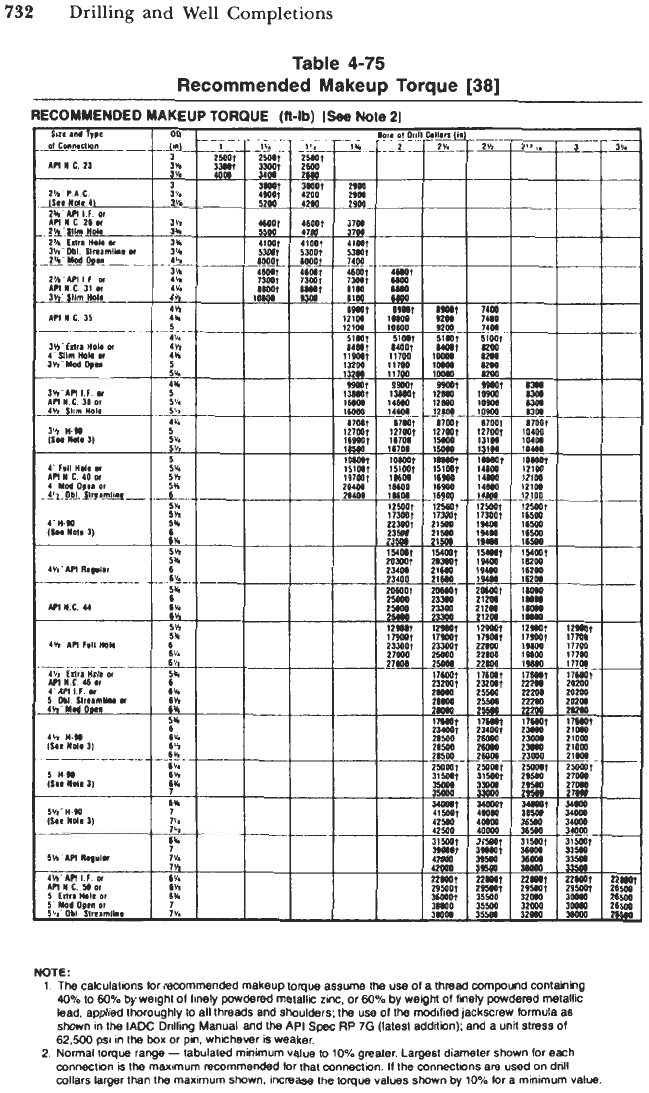
732
Drilling and Well Completions
Table
4-75
Recommended Makeup Torque
[38]
RECOMMENDED
MAKEUP
TORQUE
(ft-lb)
1%
Note
21
ZSOM
2Wt
ZSlOt
401
1%
3-
3lWt
2MO
Swot
3*0f
am
SI
49001
4200
106
Jv.
5200-
-4200
29W
APlllC
35
VI
N.C.
44
41001
1300t
10000
-
4%
5v.
5%
4li
5%
NOTE:
1
The
calculations tor recommended makeup
toque
assume
the
use
01
a
lhread
compound
containng
40%
10
60%
by weight
of
finely
powdered
metaIIIc
zm,
or
60%
by welghlol
!neb
powdered melallffi
lead,
applied thomughly
to
all threads and shoulders,
the
use
01
the modified jackscrew formula as
shown in the
IADC
Drilling
Manual and the
API
Spec
RP
7G (latest addtlnn). and a unit stress
of
62,500
psi
in the box or
pn.
whichever
IS
weaker
2
Normal toque range
-
tabulated mlnunum value
to
10%
greater Largest diameter shown for e8Ch
conneclion
is
the maxmum recommended for that connection
I1
the
conneclnns are used on dnll
collars larger than the maximum shown.
imrease
tha
toque
values shown
by
10%
lor
a mnimurn value
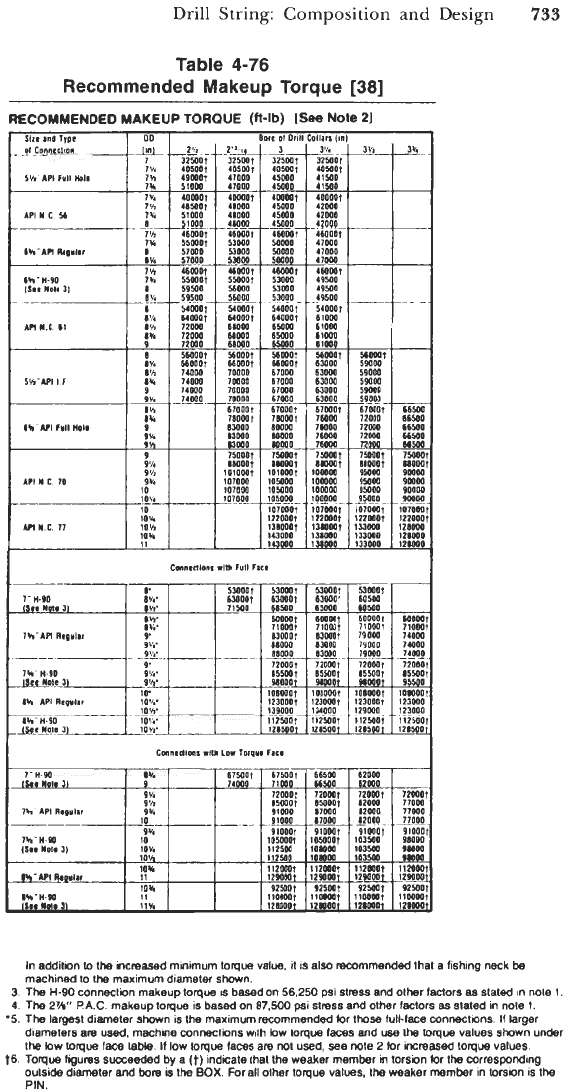
Drill String: Composition and Design
733
Table
4-76
Recommended Makeup Torque
[38]
RECOMMENDED
MAKEUP TORQUE
(fl-lb)
1%
Note
21
+.-"
32500
1%
40500
7%
49MO
1%
51000
7%
40000
7%
46500
7s
51000
I
>rm
7,h
46000
7%
55000
I
51000
In
SIOO!
ly,
46wv
1%
55MO
I
59500
I
54wo
8%
MUUP
I%
nom
-
I
..-
Y.--
5920
a+
izow
9
7zmg.
I
56000
8%
66000
I'h
74000
I+
14ow
9
14000
9%
14000
In
I+
9%
9%
9
9*
Oy,
9%
10
10%
10
10%
1O'h
10%
11
_______
325mt 405wt
41000
11ooo
4OMOt
48000
moo
(MOO
46WOt
53wo
53000
)Jaw
46WOt
SMOOt
56000
56000
YOOOt
WOOOt
6Mm
68000
38000-
YOOOt
(6000t
10000
7moo
10000
10000
67000t
780001
83000
13000
umo
15000t
8MOOt
101000t
l070W
107000
!0700!-
_~_
-
m
3%
3m0t
M30t
41500
)1y1d
4OOOOt
42000
42000
42000-
46000t
41w0
41000
__
(Iwo
moot
49500
49500
49500
54000t
61000
61000
61000
llmD
%mot
63000
63000
63000
63000
63000
67w0t
1ww
1w00
16000
*
750mt
awwt
lorn00
100000
IOWOO
10~000
IO7WOt
inmot
nmmt
Lmg-
-.
13810
In
addltmn
(0
the
ncmased
mnmum toque value.
It
IS
also recommended that a fishing neck
ba
machined to
the
maximum diameter
shown
3
The
H-90
connectan makeup torque
IS
based
on
56,250
psi stress and other faclors
aa
staled in note
1
4
The
2%''
PAC
makeup torque is
based
on
87,500
psi
stmss
and other
lactors
as
stated
n
note
1
'5
The
iawt diameter
shown
is tha maximum recommended tor
those
lull-face
Wflneclons
If
larger
diameters are used, machine wnnectans with low toque
laces
and
use
the toque values shown under
the
bw
torque
face
lable
If
low
toque
faces am not used,
see
note
2
for
mcreased torque values
t6
Toque
flgures sumeeded
by
a
(t)
indlcate
that
the weaker member
m
torston for
the
corresponding
outside diameter and bore
is
the
BOX
For all other torque values,
the
weaker member
m
torson
is
the
PIN

734
Drilling and Well Completions
(texf
continued
from
page
731)
in vertical holes has been studied by
A.
Lubinski [171] and the weight on the
bit that results in first and second order buckling can be calculated as
wcr,
=
1.94(~1p~)‘~ (4-51)
Wcrll
=
3.75( EIp2)‘/’ (4-52)
where
E
=
module of elasticity for drill collars in Ib/ft2 (for steel, E
=
4320
x
lo6
lb/ft2)
p
=
unit weight of drill collar in drilling fluid in lb/ft
I
=
moment of inertia of the drill collar cross-section with respect to its
diameter, in ft
I
=
(~/64)(D:~
-
d4,J
Ddc
=
outside diameter of drill collars in ft
ddc
=
inside diameter of drill collars in ft
Example
Find the magnitude of the weight on bit and corresponding length of drill
collars that result in second order of buckling. Drill collars: 6Q in.
x
2+ ft, mud
density
=
12 lb/gal.
Solution
Moment of inertia:
Unit weight of drill collar in drilling fluid:
p
=
108 1
-
-
=
88.181b/ft
(
6i24)
For weight on the bit that results in the second order of buckling, use
Equation 4-61:
Wcr,l,
=
3.75(4320
X
lo6
x
4.853
x
Corresponding length of drill collars:
x
88.182)’/3
=
20,468 lb
L,
=--
20’
468
-
232ft
88.18
If the total length of drill collar string would be, for example, 330 ft, then
the number “232 ft” would indicate the distance from the bit to the neutral point.
